There are many DIY jobs that you can do around the home and tiling your own kitchen splashback is one of the most easiest. Outlined below is an easy 5 step guide to ensure you tile your kitchen spash back the right way.

1. Kitchen Splashback Design
There will be some design required to create a complementary splashback for your kitchen.
TIPS
Beware the tile shops – Decide on a tile before you go shopping. Selecting tiles from tile shop at this stage will be an overwhelming and frustrating task if you don’t have a tile style in mind. Don’t go anywhere near a tile store until you have research what tile colour, pattern and finish will complement your existing kitchen. For example; if you have a white or cream kitchen you can be generous with colour, but if your kitchen cabinetry and benches are colourful choose calm white or cream tile.
- Don’t choose tiles based on fashion.
Splashback formats
There are generally two types of tiling layouts for kitchen and you will need to select which on is right for you.
- Skirting layout – One to two tiles high only. Very cost efficient and quick to install.
- Bench to cabinet layout – Bench to cabinet will be more expensive in comparison to a skirting layout as more tiles will be required.
2. Tools and materials
 You will need the following items for your tiling job.
You will need the following items for your tiling job.
- Tiles
- Tile cutter
- Damp clean sponge or cloth
- Spacers
- Tile adhesive
- Notched trowel
- Rubber trowel
- Metal rule
- Grout (colour to be selected)
- Pencil
- Spirit level
- Silicon (colour to be selected)
3. Choosing splashback grout
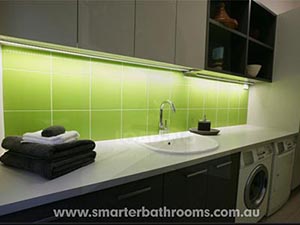 Most people starting the DIY tiling adventure rarely think about grout colours. Yes, there’s more than cream. There are many colours in fact and you will need to choose the colour that works with the theme of your kitchen. You may want the tiles to stand out individually – here you should use a lighter coloured grout than the tiles. Most people want the tile to blend with the grout, so if you choose a charcoal coloured tile you will need to choose a charcoal coloured grout.
Most people starting the DIY tiling adventure rarely think about grout colours. Yes, there’s more than cream. There are many colours in fact and you will need to choose the colour that works with the theme of your kitchen. You may want the tiles to stand out individually – here you should use a lighter coloured grout than the tiles. Most people want the tile to blend with the grout, so if you choose a charcoal coloured tile you will need to choose a charcoal coloured grout.
4. Splashback wall preparation
Fill in any uneven spaces and ensure the surface is smooth and clean. Use Sugar Soap in water and clean with a wet cloth, allow to dry. See our article on DIY plaster wall repair for more information.
5. Planning & set-out point
- Set-out point – You need to consider where to start your tiling layout. This start area is called the ‘set-out point’. If you’re planning to tile behind your cooktop for example the set-out point works well located in the centre behind the cook top. Draw a vertical line (top to bottom) on the wall behind the cooktop with your pencil and spirit level (ensure the vertical line is straight – the bubble will be in the middle of the gage).
- Detach power points – You will need to detach your power points from the wall if they are located in the area you plan to tile. This will allow you to tile under the edge of your power points plates (for a neat finish). Your power needs to be switch off from your home before you can detach your power points. Once power is off unscrew points from walls and cover with plastic bags to avoid getting adhesive or grout on the points.
- Check tile guides – Check the tile guides on the back of the tiles. On many tiles (with patterns for example) there will be arrow markings showing how tiles should be installed. Tiles that display an up arrow for example should all be fixed in the up position.
6. Installation
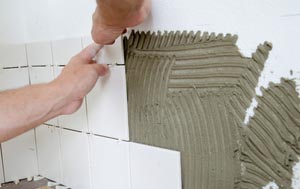 The process of installing your tiles takes a little precision. The steps are as follows:
The process of installing your tiles takes a little precision. The steps are as follows:
- Locate the first row of tiles on the wall about 3mm off the bench top.
- Trowel the adhesive onto the wall where you have located the setout point. Coat an area measuring a 300mm high x 500mm wide (or as recommended by adhesive manufacturer).
- Stop the adhesive 20mm short of the bench top.
- Scrape the adhesive upward using the notched side of the trowel. This is done to level out and spread the adhesive.
- Place two tile spacers on the bench & touching the wall, on either side of the vertical penciled centre line.
- Press the first tile onto the wall so that the vertical pencil line runs through the middle of the tile and is sitting on top of the spacers. Slightly twist the tile back and forth on the wall then hold firmly while the tile holds to the wall, but don’t use force as tile may slip.
- Add more spacers to the top of the bench (against the wall) & install more tiles working out from the centre tile on both sides of the first placed tile. Add tile spacers between tiles, these should be installed protruding outwards so they can be removed after adhesive has dried. Tile spacers can be used over and over again if they are kept clean of adhesive. Having said that spacers can alternatively be installed flush to the wall and grouted over. If you use this method push spacers firmly back onto the wall with a flat head screwdriver. Keep installing tiles row upon row until you reach the corners.
7. Cutting
Once you reach a corner tile cutting will be required. It’s rare for a tiling job not to require tiles to be cut (unless the tile layout has been previously designed).
Tools for cutting tiles
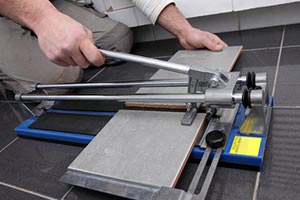 Tile cutter – Tiler Cutters cut quick, but only in a straight line.
Tile cutter – Tiler Cutters cut quick, but only in a straight line.
- Diamond edge cutter – Diamond edge cutters can cut various shapes.
- By hand – Cutting tiles by hand can be labour intensive and limits you to cutting in a straight line. Cutting tiles is best done with a tile cutter, but you can cut tiles by hand using the following methods – if the tile cut is close to the middle of the tile and the tile isn’t too thick.
- Scoring – Score the tile front repeatedly with a sturdy Stanley knife (using a metal rule to keep score straight).
- Snapping – Snap the tile by placing the score line upwards on the edge of your kitchen bench. Use one hand and your body weight to secure half the tile on the bench and the other hand to force pressure to the tile half that is not supported by the bench.
- Applying weight – Apply weight and the tile should snap. If it doesn’t’t – apply more scoring and try again.
If your tile requires only a small piece to be removed – score tile back and forth where required with a Stanley knife and snap off tile pieces with a pair of tile pincers. Always remember to install the cut tile edge facing into the corner of a wall junction where it cannot be seen once grouted. Remember, tile cutting will also be required around power points.
8. Sealing
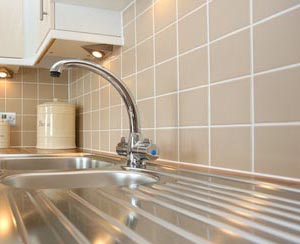 Once the tiles and glued in place they may require sealing. Check with your tile supplier about your
Once the tiles and glued in place they may require sealing. Check with your tile supplier about your
particular tiles. Apply sealer as recommended by manufacturer.
9. Grouting
Ensure you have selected a grout colour that matches your tiles and follow these few simple steps:
- Clean tiles – Wipe down tiles with damp cloth and allow to dry. Don’t forget to wipe the corners where the tiles and bench top meet.
- Prepare grout – Mix grout as per manufactures instructions.
- Working grout into joints – Apply grout with a rubber based trowel (or something similar) and work into the tile joints. You can grout an area of 500x1000mm in a single go and then remove excess.
- Removing excess grout – Remove excess grout from tiles by scraping the excess off with a rubber trowel, then wipe over tiles with a barely damp cloth to remove excess further. Paying attention to joins.
- Final clean – Once the tiles have been grouted and cleaned off as much as possible (till the cloth is clean when you wipe over the tiled surface), it’s time to silicon.
The last top row of tiles does not need to be grouted but can either be;
- Covered with a tile trimmer.
- Painted – If tiles are uncut the top of the tiles can be painted the same colour as the wall.
- Siliconed – Uncut tiles can be siliconed and smoothed with finger for a neat finish.
10. Silicon corners
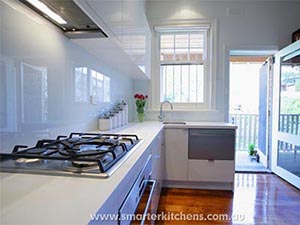 Whenever a tile meets a cabinet or wall junction a gap (of about 2mm wide) must be left to allow for expansion and contraction. Silicon can then be applied into these gap
Whenever a tile meets a cabinet or wall junction a gap (of about 2mm wide) must be left to allow for expansion and contraction. Silicon can then be applied into these gap
s and wiped off with your finger. Ensure the silicon matches your tile colour.
11. Clean up
Use a damp cloth to wipe any grout off the kitchen bench and pay particular attention to the corners. Fill the corners with silicon and smooth off with your finger, this will be the last thing to do then your tiling is complete.







